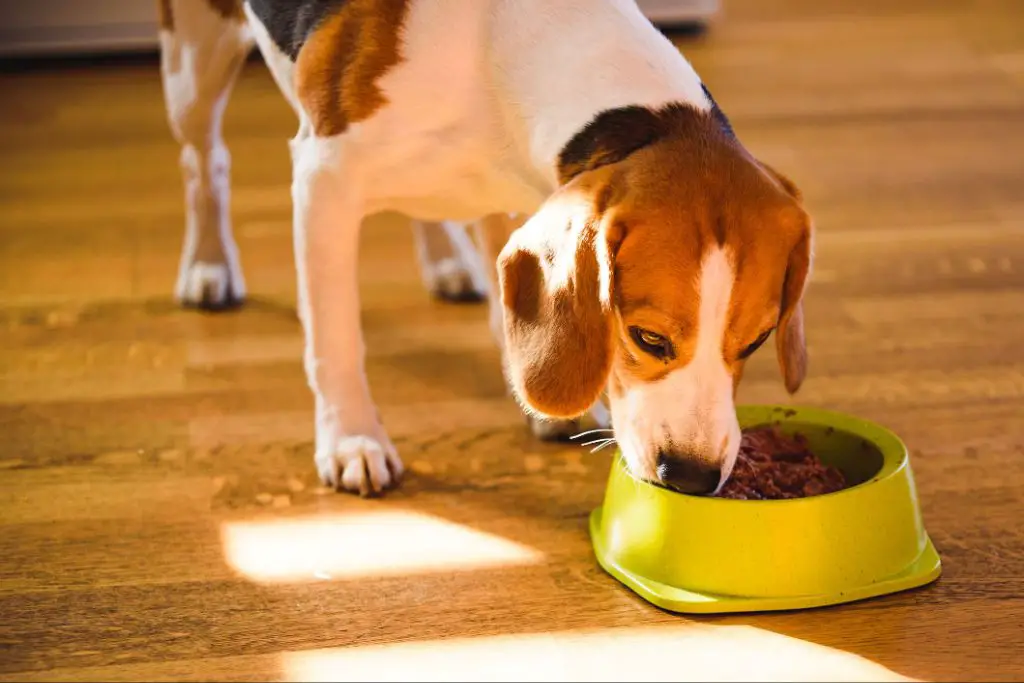Introduction
The debate between wet versus dry dog food is an ongoing one among pet owners. On one side, advocates of wet food argue that it is more palatable and healthier for dogs. On the other side, proponents of dry kibble claim it is more affordable and convenient to store and feed. There are merits to both types of dog food, so the choice between wet and dry often comes down to a dog’s unique needs and an owner’s lifestyle and budget. When choosing between wet or dry food, some key factors to consider are moisture content, dental health, nutrition profile, cost, storage, allergies, flavors, and weight management. This article will examine the pros and cons of wet and dry dog food across these factors to help owners make an informed decision.
Moisture Content

One of the biggest differences between wet and dry dog food is the moisture content. Wet foods typically contain around 75% moisture, whereas dry foods contain only around 10% moisture. This high moisture content is a major advantage of wet food.
Water is extremely important for dog health. Dogs’ bodies contain around 60% water, and they need plenty of water each day to stay hydrated. Hydration supports all bodily functions including digestion, nutrient absorption, oxygen transport, joint health, and more.
The high moisture content of wet food contributes a significant amount of water to your dog’s daily water intake. This helps ensure they stay well hydrated, which is especially important for senior dogs or dogs prone to urinary tract conditions. The extra hydration from wet food can be beneficial for dogs who don’t always drink as much water as they should.
So if you want to increase your dog’s moisture intake, wet dog food can make achieving proper hydration easier. The high water content provides an easy way to add more water to your dog’s diet.
Dental Health
One potential advantage of dry dog food is that it can help clean your dog’s teeth as they chew. The crunchy texture scrapes away plaque and tartar, helping to reduce the risk of periodontal disease. This effect is similar to dental chews.

The kibble’s abrasive surface scrubs the surfaces of teeth to remove stuck-on food and bacteria. Chewing also stimulates saliva production, which can neutralize bad bacteria in the mouth. Plus, ingredients like calcium can strengthen tooth enamel.
However, dry food isn’t quite as effective as brushing your dog’s teeth or professional dental cleanings. It shouldn’t replace proper dental care, but can be a beneficial supplement. Look for larger, denser kibbles for more scrubbing action.
Wet foods don’t provide this teeth-cleaning benefit – they are soft and easily broken down. Some pet owners mix wet and dry food to try to get the best of both.
Nutrition
When it comes to the nutritional makeup of wet and dry dog food, there are some key differences to consider.
Protein – Most experts recommend dogs get 18-27% of their calories from protein. Both wet and dry foods contain ample protein, but the quality can vary. Wet foods often contain more animal-based proteins, while dry foods rely more on plant proteins. Animal proteins are considered higher quality.
Fats – Wet dog foods tend to be higher in fat, around 20-25% of calories. This is beneficial for young, active, or underweight dogs. Dry foods are lower in fat at 10-15% of calories, which can be better for less active or overweight dogs.
Carbohydrates – Dry dog foods contain more carbs from grains, veggies and starches, around 50% or more of calories. Wet foods are lower in carbs at under 40% of calories. Lower carb diets can be preferable for dogs with certain health conditions.
Overall, wet and dry foods can both provide balanced nutrition. Look for quality proteins as the first ingredient and aim for the appropriate fat and carb content based on your dog’s needs.
Cost
One of the main differences between wet and dry dog food is cost. Wet food is generally more expensive than dry kibble. There are a few reasons for this:
– Wet food contains more moisture (around 75% moisture vs. 10% for dry food), so you are paying for that additional water content.
– The process of canning wet food is more complex than producing dry kibble. This manufacturing process costs more money, which gets passed onto the consumer.
– Wet food tends to use higher quality ingredients like fresh meats which cost more than grain fillers commonly found in dry food.
– Wet food is sold in cans or pouches, which have additional packaging costs compared to bags for dry kibble.
– Wet food requires refrigeration after opening, increasing storage and shipping costs.
– Shelf life is shorter for wet foods than dry kibble, adding waste and production costs.
On average, wet dog food can cost anywhere from 2-4 times as much as dry kibble. However, it may still be worth it for the benefits of increased moisture, better taste, and the possible health advantages of wet food.
Storage and Convenience
Dry dog food offers more convenience when it comes to storage. Kibble can be left out in the dog’s bowl without worry of spoilage. As long as it’s kept free of moisture, dry dog food can last for days in the bowl or weeks in an airtight container.

Wet dog food, on the other hand, requires refrigeration after opening. Like canned human foods, opened cans of wet dog food must be stored in the fridge to prevent bacterial growth. Any uneaten portion should be discarded within a couple of days. This makes wet food less convenient than dry kibble for multi-pet households.
Some pet owners opt for dry food for its ease of storage and ability to be left out all day for free-feeding. Wet food requires more effort as any leftovers must be promptly refrigerated or discarded. For those looking for a convenient way to always have food available, dry kibble is the simpler way to go.
Allergies
Some dogs may have allergies or sensitivities to certain ingredients commonly found in wet or dry dog foods. Both wet and dry foods can contain potential allergens like grains, meat proteins, artificial preservatives and coloring. It’s important to read the ingredient list carefully if your dog has any known allergies.
Some problematic ingredients in wet food can include wheat, corn, soy, dairy products, eggs, chicken, beef or fish. Dry kibbles often contain grains, chicken, beef or fish as well.
Consult with your veterinarian if you suspect your dog has a food allergy. They can help identify the allergen and recommend a hypoallergenic diet, whether it’s wet, dry, raw or home cooked.
Flavor
When it comes to flavor, wet dog food often wins over dry kibble. The high moisture content allows for more aroma and taste. Since wet food contains around 75% water, the remaining 25% is protein, fat, and carbohydrates condensed into a small serving size. This concentration leads to a richness and intensity of flavor that dry kibble cannot match.

The meat ingredients in wet food are less processed than in kibble, retaining more of their natural taste. Whole chunks of meat or pâté style wet foods often smell appetizing to dogs. The gravy or sauce also releases savory aromas. With more moisture to dissolve the flavor compounds, dogs experience a burst of meaty, delicious taste with each bite.
Kibble relies more heavily on synthetic flavor enhancers to try to mimic the taste of real meats. But these artificial flavors cannot fully replicate the appetizing aroma and juiciness of fresh meat ingredients. The carbohydrate content also dilutes the flavor compared to protein-dense wet foods.
For picky eaters or dogs that have lost interest in their usual dry food, transitioning to wet foods often reawakens their enthusiasm for mealtime. The richer flavor profile and variety of textures make wet food more palatable. For dogs that wolf down their kibble, wet food can provide a more satisfying eating experience.
Weight Management
One potential advantage of wet dog food is that it may help overweight dogs feel fuller compared to dry kibble. Kibble is low in moisture and high in carbohydrates. This can lead some dogs to keep eating more kibble past the point of feeling full.
Wet food typically has much higher moisture content, usually around 75-85%. This extra moisture provides more volume and weight to the food even though it has fewer calories. The increased volume can help create a feeling of fullness faster in dogs.
This satiating effect means dogs may feel satisfied with smaller portion sizes of wet food compared to dry kibble. Eating less overall can help overweight dogs lose excess body fat when combined with exercise.
That being said, wet food still contains calories and dogs will gain weight if overfed. Portion control based on your dog’s needs is essential. Consult your vet on appropriate portion sizes and weight loss plans if your dog requires a special diet.
Conclusion
In conclusion, there are pros and cons to consider with both wet and dry dog food. Here is a brief summary:
Pros of wet dog food:
- Higher moisture content
- Better for dental health
- More palatable flavors
Cons of wet dog food:
- More expensive per serving
- Shorter shelf life
- Messier to serve and store
Pros of dry dog food:
- Less expensive per serving
- Longer shelf life
- Easier to measure portions
- More convenient to store and serve
Cons of dry dog food:
- Lower moisture content
- Less appealing texture and flavor
- Can be difficult for some dogs to chew and digest
When choosing between wet or dry food, pet owners need to consider their budget, their dog’s preferences, health needs, and lifestyle factors. Many experts recommend feeding a combination of both wet and dry food to obtain optimal nutrition and health benefits.